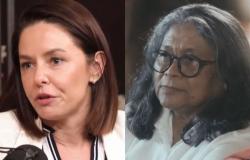And yet, we’re talking about a made-up world full of magic and monsters. There are many points where fans come across facts that seem less likely. Are Hobbits really related to Men? How do vision stones work? What’s the point of Rings of Power? Knowing that Tolkien oversaw their creation makes it easier to simply accept most of these items at face value, but they still require careful thought. Here are five canonical facts from the Lord of the Rings story that seem so far-fetched that they seem false at first glance – even though they are completely true.
The Uruk-hai may be half human
In Peter Jackson’s adaptation of “The Lord of the Rings,” the Uruk-hai have a clear origin. They are a unique creation created by Saruman in the wells of Orthanc. We even see them emerging from the mud and dirt. This is based on some of the earliest Middle-earth Orc origin stories that Tolkien wrote, where he simply has his villainous Orcs emerge from underground slime and heat.
However, the author abandoned this version of the origin of the Orcs quite early, opting for a more cunning evolution – one that on several occasions included either Men or Elves. And in the case of the Uruk-hai, it is probably the latter.
The term “Uruk” refers to a particularly nasty form of Orc. In the appendices of “The Return of the King”, it says that about 500 years before “The Lord of the Rings”, “the race of Uruks, black Orcs of great strength, first appeared outside of Mordor”. Half a millennium later, they were common in the Dark Lord’s armies.
In The Two Towers, Fangorn expresses his suspicions about Saruman’s diabolical experiments in Uruk-inspired racial hybridization, saying: “He has done something to them; something dangerous. For these Isengardians are more like wicked Men.” He continues to surmise: “Was it Men he ruined, or did he mix the races of Orcs and Men? That would be black evil!”
A little later, we also have a conversation during the battle of Helm’s Deep, where an officer from Rohan says: “But these creatures of Isengard, these half-orcs and goblin men that Saruman’s nefarious trickery has created, will not cower before of the sun”. Although we never have a definitive answer, Tolkien’s writings strongly suggest the possibility that the Uruk-hai are not monsters born from mud. They are half human.

Hobbits really hate water
Hobbits are a shy race. The heroic acts of Frodo, Merry, Pippin, and Sam stand out in part because their fellow Hobbits are not only afraid of common enemies such as Orcs and Trolls, but also of Elves and Men. While their inherent shyness is evident in the films, only fans of the books know that most Hobbits also have a petrifying fear of water. Sure, they drink the water, but throw them into a river or a deep lake, and they’re as good as dead.
At the beginning of the book The Fellowship of the Ring, we discover that Frodo’s parents die tragically in a boating accident – they both drown. The Hobbits who hear the story make it clear that their willingness to play with boats in the first place was a rookie mistake.
Likewise, when the Fellowship of the Ring leaves Lothlórien in Elven ships, the text makes a point of describing Sam as follows: Sam sat in the prow, holding the sides and looking longingly at the shore.
Merry Brandybuck’s large extended family is said to be a peculiar group of Hobbits who live on the edge of Middle-earth. The book The Fellowship of the Ring explains the main distinction between them and other Halflings, saying that they were generally the same, except for one thing: they liked boats, and some of them could swim.
This little bit of information about the Hobbits makes one act, in particular, all the more important. When Sam throws himself into the water trying to reach Frodo at the end of The Fellowship of the Ring, he’s not just being reckless. He’s facing a paralyzing fear of water – which is just one more reason why Sam is one of the greatest heroes in all of fantasy lore.

Galadriel is the same maturity as a 93-year-old human in The Lord of the Rings
Tolkien was a perfectionist. The Oxford Professor even spent countless hours grappling with the concept of – believe it or not – elven aging. While we casually refer to the Elves of Middle-earth as immortal, the truth is that they mature, albeit slowly. Tolkien developed different formulas that tried to make sense of this process, and in the book The Nature of Middle-earth, he gives us enough information to roughly calculate Galadriel’s maturity during The Lord of the Rings.
The basic idea is that Elves in Middle-earth tend to age relatively quickly early in their lives, as their bodies mature physically. After that, they aged at a ratio of 100 to 1 compared to humans. In the excerpt from the book titled Aging of Elves, Tolkien explains that Galadriel had just reached maturity when she arrived in Middle-earth. The text says: Therefore, she was 22 years old when she entered Beleriand and so lived in the ratio of 100:1. With the ruin of Beleriand in ME 590, she was therefore around 28 years old.
The Lord of the Rings takes place two ages after this event. The Second Age is approximately 3,500 years long, and the Third Age is just over 3,000 years long. Add them up and then divide them by 100, and you get 65. Add that to the original 28, and, at least according to this formula, Galadriel has matured to the respectable age of 93 by the time of The Lord of the Rings. Of course, this is just one model that Tolkien explored, but it helps explain why Galadriel was more impulsive earlier in the stories and has become a calm, veteran leader by the time Frodo finds her in Lothlórien.

The village of Bree is older than Elrond – and has Hobbit inhabitants
Elrond is quite old. By the time of The Lord of the Rings, he is over six thousand years old. When you live this long, most physical structures and cities disappear and are replaced by new models. But there is a modest village, hidden up there near the Shire, that is actually older than the Elvish advisor when Frodo and his fellow Hobbits drop by for ale. That’s right. The village of Bree is older than Elrond.
The book The Fellowship of the Ring presents the Men of Bree saying: According to their own stories, they were the original inhabitants and were descendants of the first Men who ever wandered westward from the middle world. It goes on to explain: Few survived the tumults of the Old Days; but when the Kings returned again over the Great Sea, they found the Men of Bree still there, and they were still there now, when the memory of the ancient Kings had faded into the grass.
This brave little city of Men dates back to the Elder Days (code for the First Age of Middle-earth and before). By comparison, Elrond was born half a century before the end of the Elder Days. While we technically don’t have a founding date for Bree, for all intents and purposes the settlement appears to be significantly older than Elrond.
Oh, and did we mention there are also Hobbits? Peter Jackson’s depiction of the city is a dirty warehouse dominated by Men. However, Tolkien’s original version is a little cleaner and more encouraging. Bree is also the only place in Middle-earth where Men and Hobbits (the Great and the Little, respectively) live in harmony together.

Elrond, Arwen and even Aragorn are angels
In general, most of Tolkien’s races intermarry and reproduce internally. Having a relationship with someone from another group is frowned upon, and Aragorn and Arwen’s marriage is extremely unique in the history of Middle-earth. Technically speaking, however, they are not the only human/elven marriage. At two different points, both of their lineages (which are distant) include a Man marrying an Elvenwoman. These are technically the only three official times where Tolkien records Humans and Elves getting married, and they all take place in the same family tree, which includes a ton of famous figures.
The surprise comes when the half-elven offspring aren’t the craziest part of this totally unique genealogical group. This happens way back in the beginning, when a royal Elven ancestor marries an angel. Early in the history of Middle-earth, the Elven king Thingol meets, falls in love with, and marries a lovely girl named Melian. Melian is a Maiar, a race of spirits who help oversee the affairs of the world in the name of their Creator. Some Maiar are more powerful than others, and some are corrupt, like Sauron and the Balrog. The Five Mages are also Maiar in physical bodies. In the book Unfinished Tales, Tolkien describes the Maiar as people of the angelic order, adding: The Maiar were spirits, but capable of self-incarnation, and could assume human (especially Elvish) forms.
Melian takes on a physical, humanoid form and marries her handsome Elven king. They have a daughter named Lúthien, who she meets and falls in love with a mortal named Beren. From then on, the family story is in full swing. Eventually, Elrond appears, and Galadriel’s daughter marries into the family – a family with the unique characteristic that every member related by blood is part angel.










